Strategic Plan Report for Dairy Product Australia Company, Analysis
VerifiedAdded on 2020/03/01
|14
|2408
|131
Report
AI Summary
This report provides a strategic plan analysis for Dairy Product Australia, evaluating its current market position and future opportunities. The report begins with an executive summary and an introduction outlining the report's objectives. It then delves into an analysis of the simulation firm, followed by PESTEL and SWOT analyses to assess the external and internal environments, respectively. The report identifies gaps in the firm, defines objectives for the company and its functional areas, and outlines strategies for each functional area as well as an overall business-level strategy. It also addresses potential contingencies and constraints to the strategy's implementation. The report concludes with recommendations to improve the company's market penetration and overall performance. Key areas of focus include creative marketing, customer engagement, and product diversification.
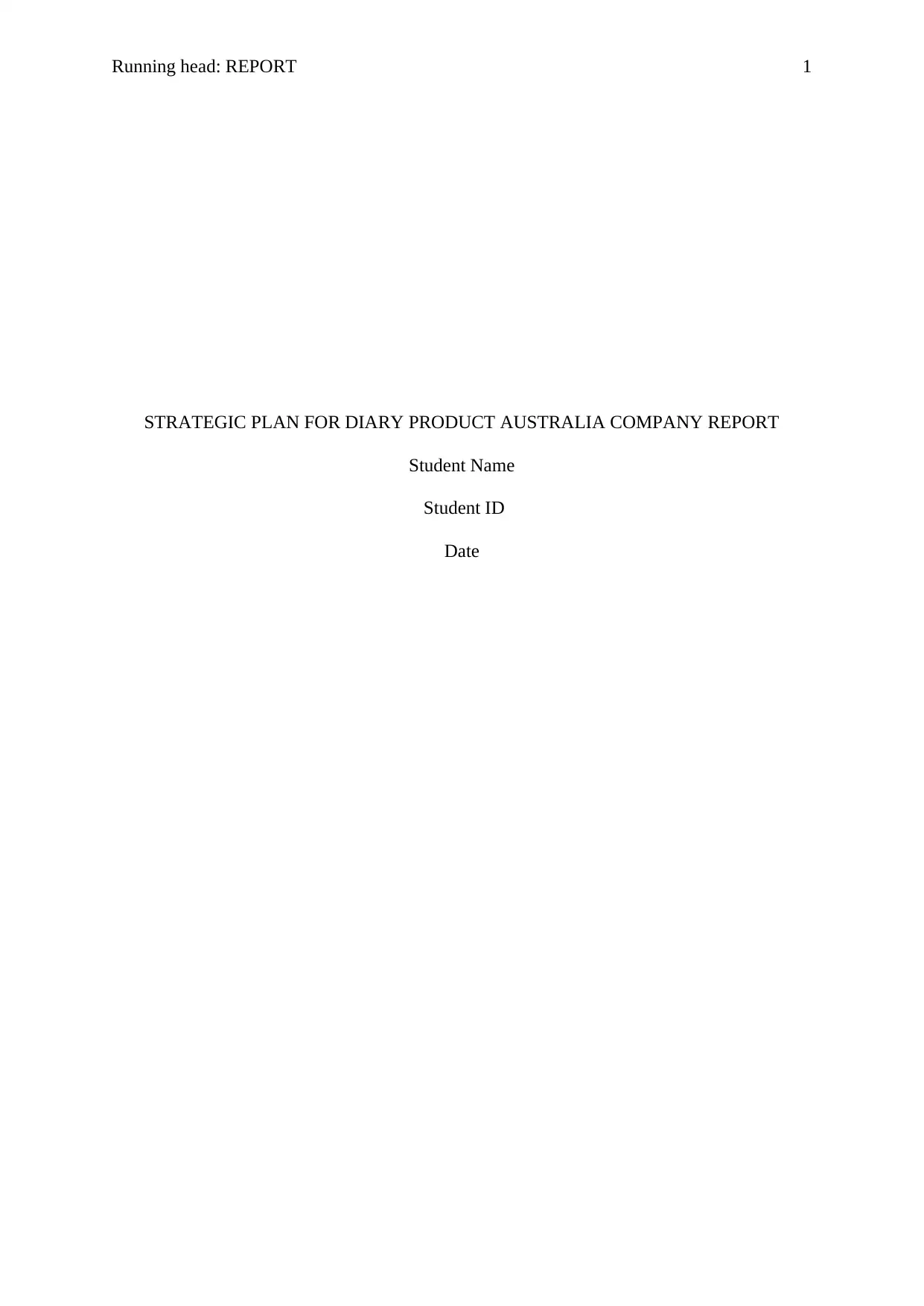
Running head: REPORT 1
STRATEGIC PLAN FOR DIARY PRODUCT AUSTRALIA COMPANY REPORT
Student Name
Student ID
Date
STRATEGIC PLAN FOR DIARY PRODUCT AUSTRALIA COMPANY REPORT
Student Name
Student ID
Date
Paraphrase This Document
Need a fresh take? Get an instant paraphrase of this document with our AI Paraphraser
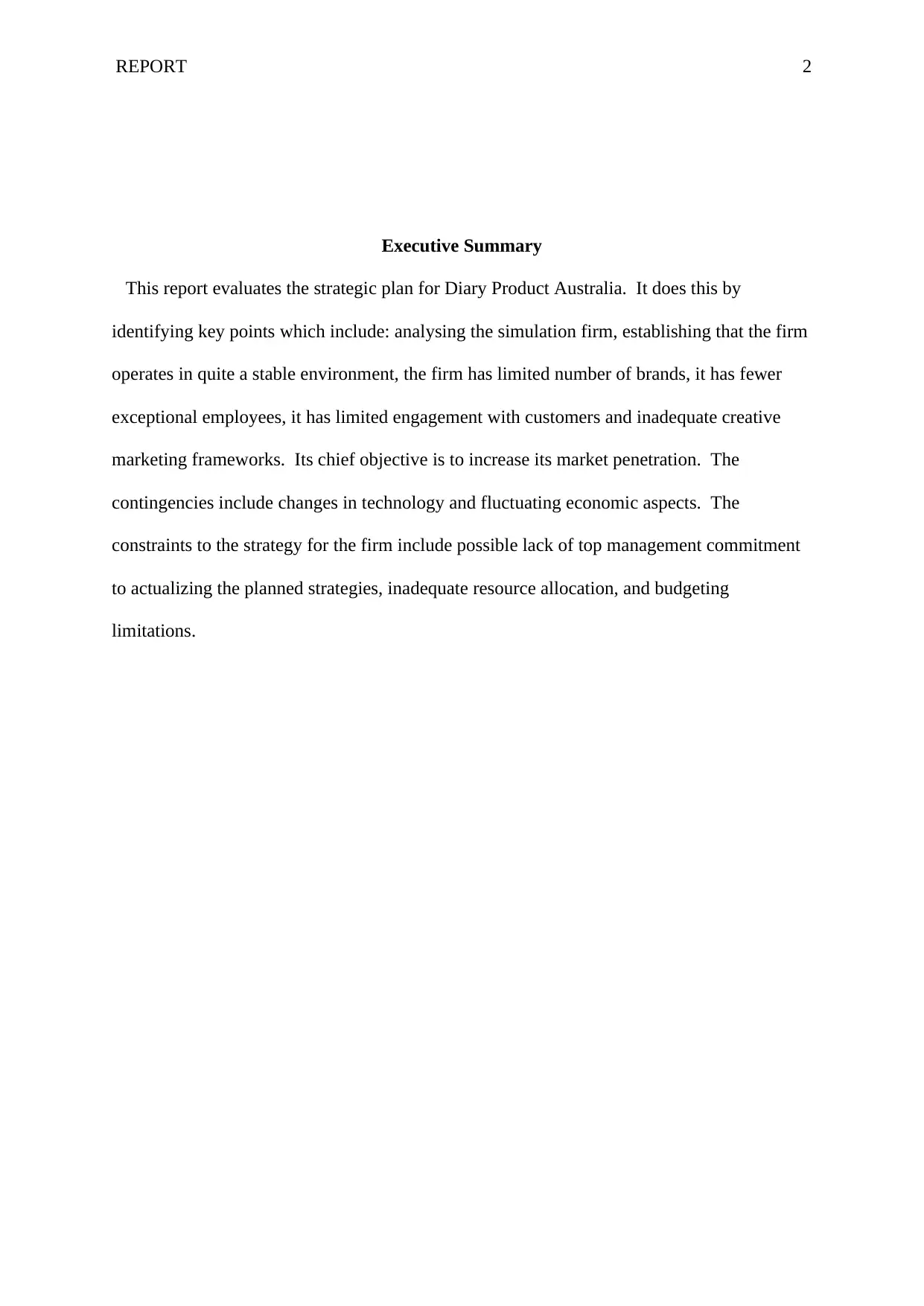
REPORT 2
Executive Summary
This report evaluates the strategic plan for Diary Product Australia. It does this by
identifying key points which include: analysing the simulation firm, establishing that the firm
operates in quite a stable environment, the firm has limited number of brands, it has fewer
exceptional employees, it has limited engagement with customers and inadequate creative
marketing frameworks. Its chief objective is to increase its market penetration. The
contingencies include changes in technology and fluctuating economic aspects. The
constraints to the strategy for the firm include possible lack of top management commitment
to actualizing the planned strategies, inadequate resource allocation, and budgeting
limitations.
Executive Summary
This report evaluates the strategic plan for Diary Product Australia. It does this by
identifying key points which include: analysing the simulation firm, establishing that the firm
operates in quite a stable environment, the firm has limited number of brands, it has fewer
exceptional employees, it has limited engagement with customers and inadequate creative
marketing frameworks. Its chief objective is to increase its market penetration. The
contingencies include changes in technology and fluctuating economic aspects. The
constraints to the strategy for the firm include possible lack of top management commitment
to actualizing the planned strategies, inadequate resource allocation, and budgeting
limitations.
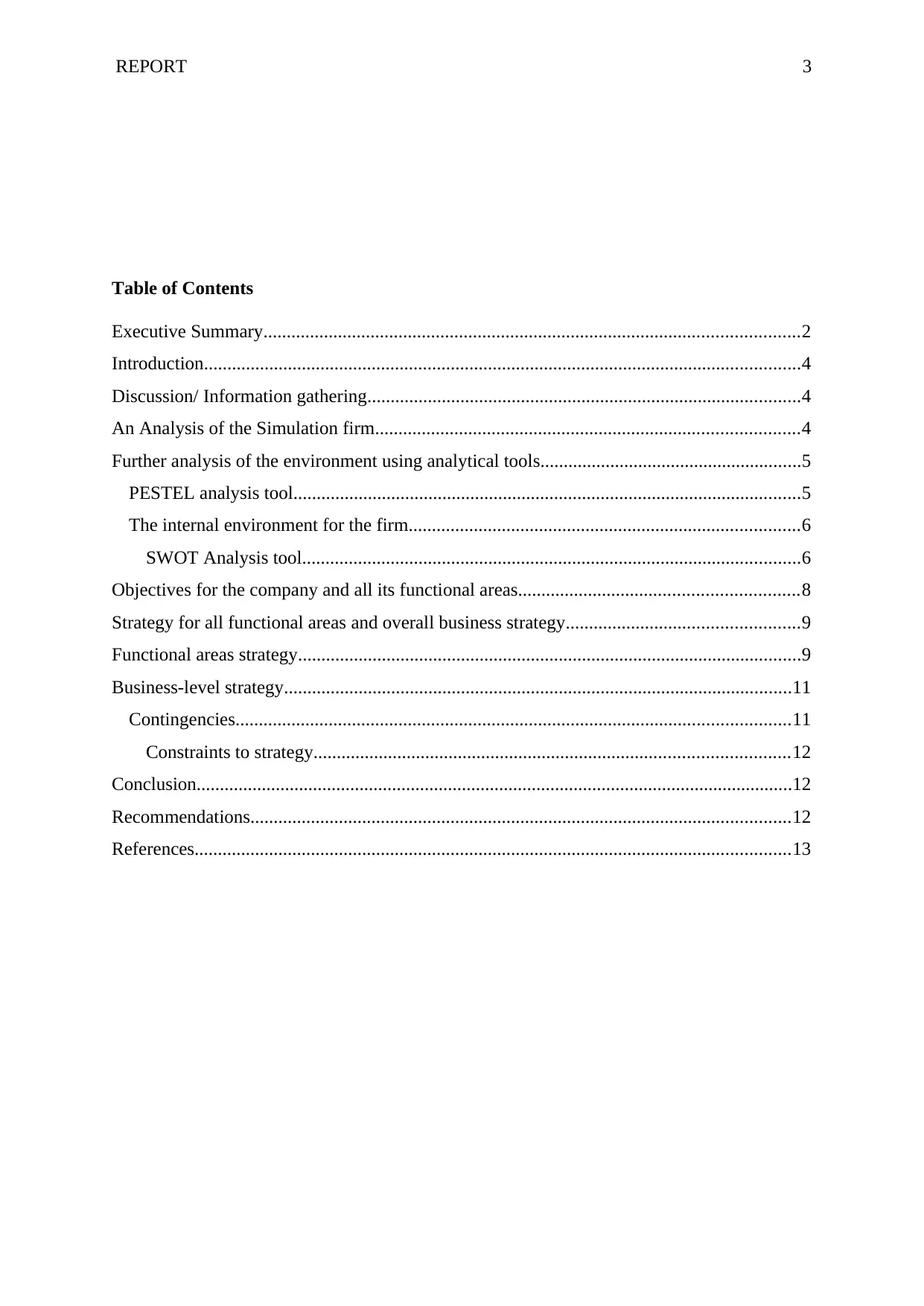
REPORT 3
Table of Contents
Executive Summary...................................................................................................................2
Introduction................................................................................................................................4
Discussion/ Information gathering.............................................................................................4
An Analysis of the Simulation firm...........................................................................................4
Further analysis of the environment using analytical tools........................................................5
PESTEL analysis tool.............................................................................................................5
The internal environment for the firm....................................................................................6
SWOT Analysis tool...........................................................................................................6
Objectives for the company and all its functional areas............................................................8
Strategy for all functional areas and overall business strategy..................................................9
Functional areas strategy............................................................................................................9
Business-level strategy.............................................................................................................11
Contingencies.......................................................................................................................11
Constraints to strategy......................................................................................................12
Conclusion................................................................................................................................12
Recommendations....................................................................................................................12
References................................................................................................................................13
Table of Contents
Executive Summary...................................................................................................................2
Introduction................................................................................................................................4
Discussion/ Information gathering.............................................................................................4
An Analysis of the Simulation firm...........................................................................................4
Further analysis of the environment using analytical tools........................................................5
PESTEL analysis tool.............................................................................................................5
The internal environment for the firm....................................................................................6
SWOT Analysis tool...........................................................................................................6
Objectives for the company and all its functional areas............................................................8
Strategy for all functional areas and overall business strategy..................................................9
Functional areas strategy............................................................................................................9
Business-level strategy.............................................................................................................11
Contingencies.......................................................................................................................11
Constraints to strategy......................................................................................................12
Conclusion................................................................................................................................12
Recommendations....................................................................................................................12
References................................................................................................................................13
⊘ This is a preview!⊘
Do you want full access?
Subscribe today to unlock all pages.

Trusted by 1+ million students worldwide
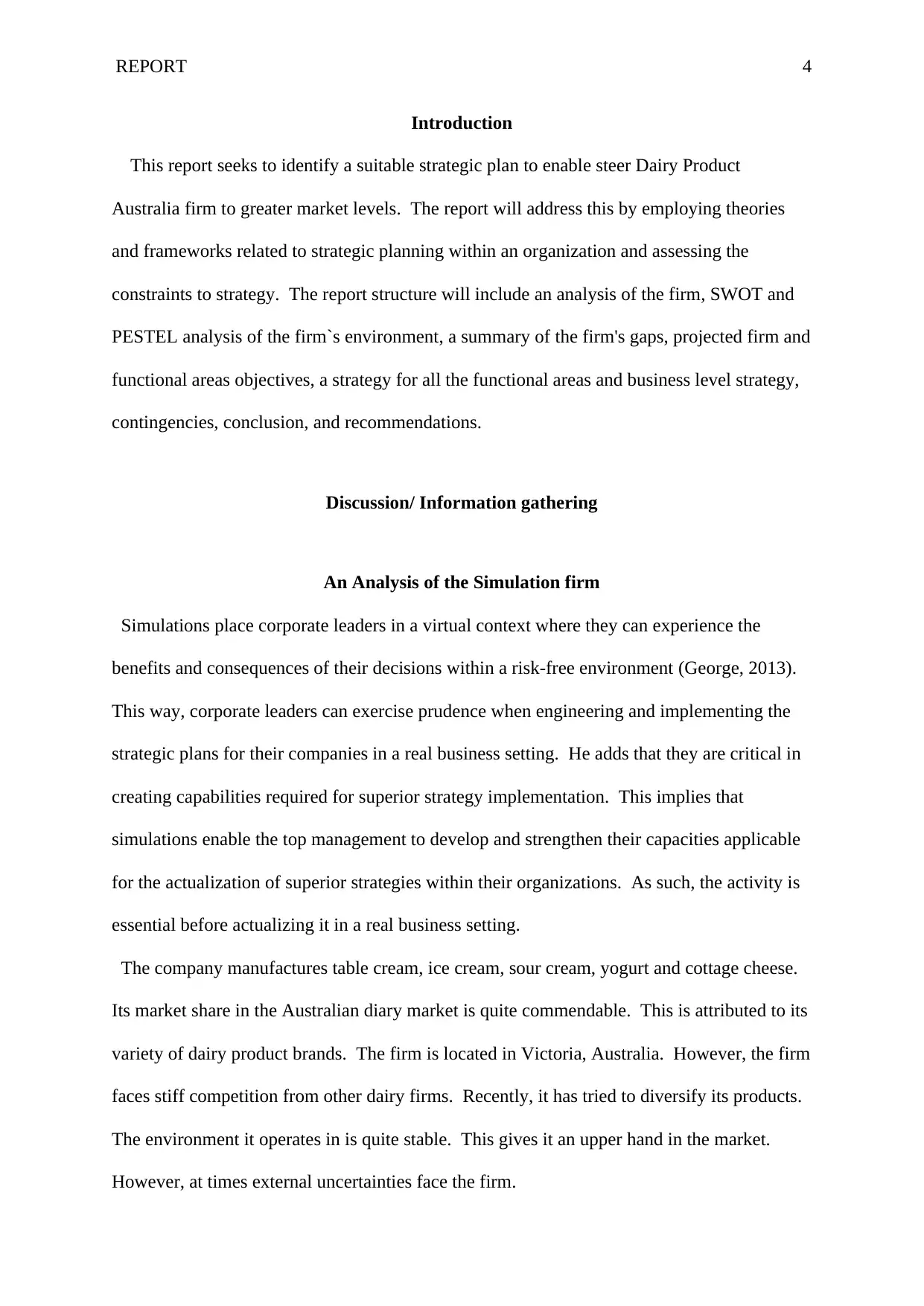
REPORT 4
Introduction
This report seeks to identify a suitable strategic plan to enable steer Dairy Product
Australia firm to greater market levels. The report will address this by employing theories
and frameworks related to strategic planning within an organization and assessing the
constraints to strategy. The report structure will include an analysis of the firm, SWOT and
PESTEL analysis of the firm`s environment, a summary of the firm's gaps, projected firm and
functional areas objectives, a strategy for all the functional areas and business level strategy,
contingencies, conclusion, and recommendations.
Discussion/ Information gathering
An Analysis of the Simulation firm
Simulations place corporate leaders in a virtual context where they can experience the
benefits and consequences of their decisions within a risk-free environment (George, 2013).
This way, corporate leaders can exercise prudence when engineering and implementing the
strategic plans for their companies in a real business setting. He adds that they are critical in
creating capabilities required for superior strategy implementation. This implies that
simulations enable the top management to develop and strengthen their capacities applicable
for the actualization of superior strategies within their organizations. As such, the activity is
essential before actualizing it in a real business setting.
The company manufactures table cream, ice cream, sour cream, yogurt and cottage cheese.
Its market share in the Australian diary market is quite commendable. This is attributed to its
variety of dairy product brands. The firm is located in Victoria, Australia. However, the firm
faces stiff competition from other dairy firms. Recently, it has tried to diversify its products.
The environment it operates in is quite stable. This gives it an upper hand in the market.
However, at times external uncertainties face the firm.
Introduction
This report seeks to identify a suitable strategic plan to enable steer Dairy Product
Australia firm to greater market levels. The report will address this by employing theories
and frameworks related to strategic planning within an organization and assessing the
constraints to strategy. The report structure will include an analysis of the firm, SWOT and
PESTEL analysis of the firm`s environment, a summary of the firm's gaps, projected firm and
functional areas objectives, a strategy for all the functional areas and business level strategy,
contingencies, conclusion, and recommendations.
Discussion/ Information gathering
An Analysis of the Simulation firm
Simulations place corporate leaders in a virtual context where they can experience the
benefits and consequences of their decisions within a risk-free environment (George, 2013).
This way, corporate leaders can exercise prudence when engineering and implementing the
strategic plans for their companies in a real business setting. He adds that they are critical in
creating capabilities required for superior strategy implementation. This implies that
simulations enable the top management to develop and strengthen their capacities applicable
for the actualization of superior strategies within their organizations. As such, the activity is
essential before actualizing it in a real business setting.
The company manufactures table cream, ice cream, sour cream, yogurt and cottage cheese.
Its market share in the Australian diary market is quite commendable. This is attributed to its
variety of dairy product brands. The firm is located in Victoria, Australia. However, the firm
faces stiff competition from other dairy firms. Recently, it has tried to diversify its products.
The environment it operates in is quite stable. This gives it an upper hand in the market.
However, at times external uncertainties face the firm.
Paraphrase This Document
Need a fresh take? Get an instant paraphrase of this document with our AI Paraphraser
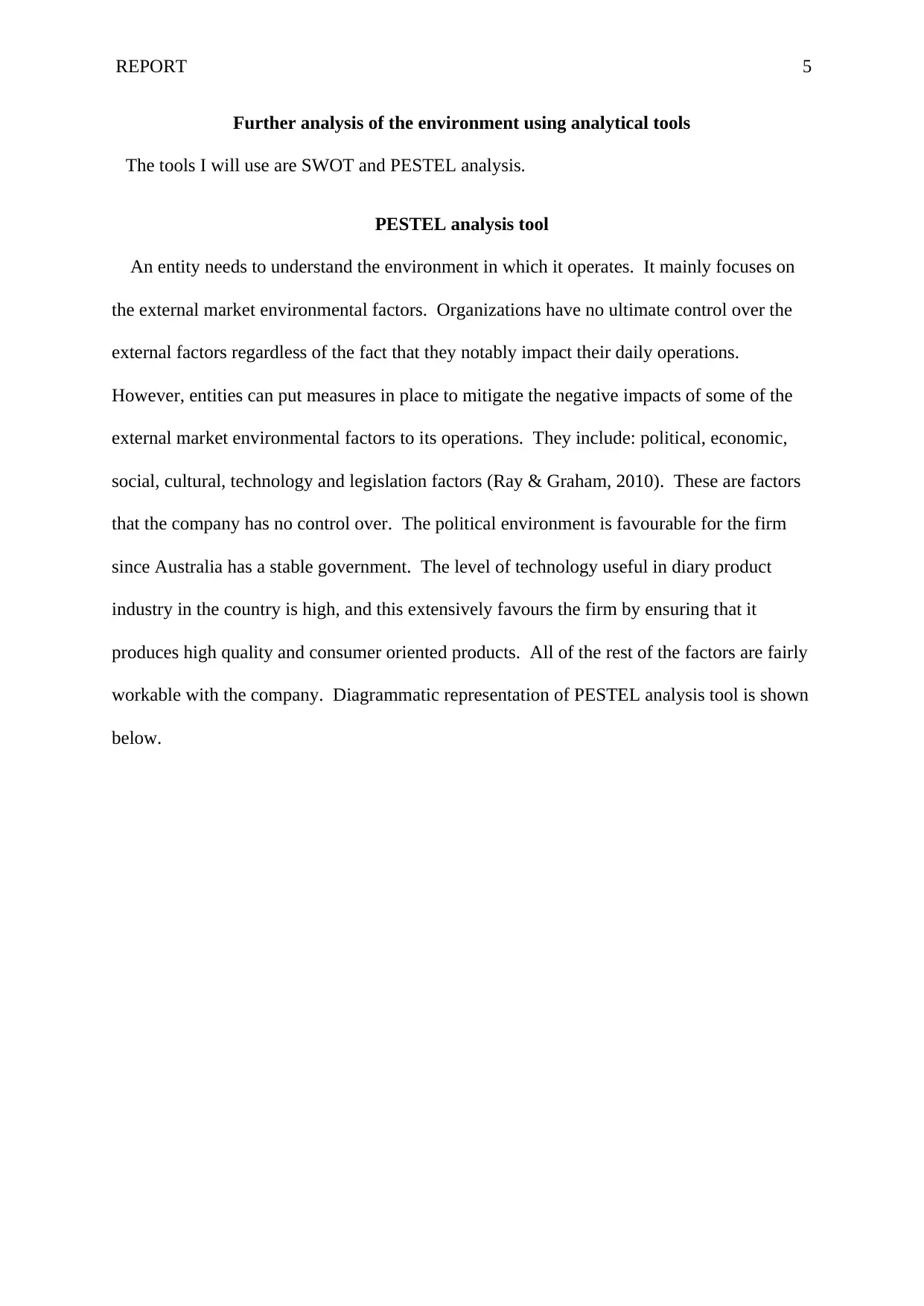
REPORT 5
Further analysis of the environment using analytical tools
The tools I will use are SWOT and PESTEL analysis.
PESTEL analysis tool
An entity needs to understand the environment in which it operates. It mainly focuses on
the external market environmental factors. Organizations have no ultimate control over the
external factors regardless of the fact that they notably impact their daily operations.
However, entities can put measures in place to mitigate the negative impacts of some of the
external market environmental factors to its operations. They include: political, economic,
social, cultural, technology and legislation factors (Ray & Graham, 2010). These are factors
that the company has no control over. The political environment is favourable for the firm
since Australia has a stable government. The level of technology useful in diary product
industry in the country is high, and this extensively favours the firm by ensuring that it
produces high quality and consumer oriented products. All of the rest of the factors are fairly
workable with the company. Diagrammatic representation of PESTEL analysis tool is shown
below.
Further analysis of the environment using analytical tools
The tools I will use are SWOT and PESTEL analysis.
PESTEL analysis tool
An entity needs to understand the environment in which it operates. It mainly focuses on
the external market environmental factors. Organizations have no ultimate control over the
external factors regardless of the fact that they notably impact their daily operations.
However, entities can put measures in place to mitigate the negative impacts of some of the
external market environmental factors to its operations. They include: political, economic,
social, cultural, technology and legislation factors (Ray & Graham, 2010). These are factors
that the company has no control over. The political environment is favourable for the firm
since Australia has a stable government. The level of technology useful in diary product
industry in the country is high, and this extensively favours the firm by ensuring that it
produces high quality and consumer oriented products. All of the rest of the factors are fairly
workable with the company. Diagrammatic representation of PESTEL analysis tool is shown
below.
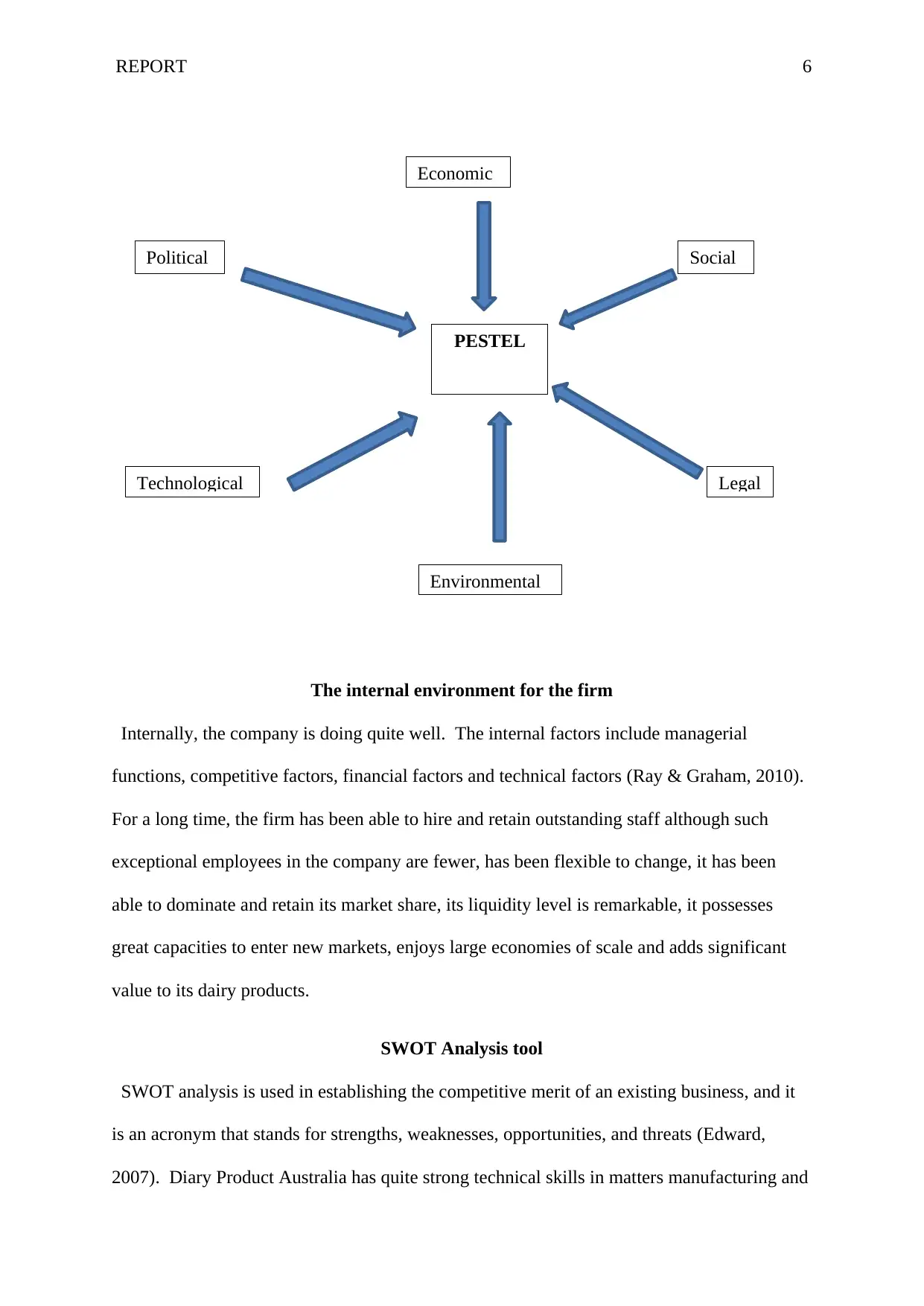
REPORT 6
The internal environment for the firm
Internally, the company is doing quite well. The internal factors include managerial
functions, competitive factors, financial factors and technical factors (Ray & Graham, 2010).
For a long time, the firm has been able to hire and retain outstanding staff although such
exceptional employees in the company are fewer, has been flexible to change, it has been
able to dominate and retain its market share, its liquidity level is remarkable, it possesses
great capacities to enter new markets, enjoys large economies of scale and adds significant
value to its dairy products.
SWOT Analysis tool
SWOT analysis is used in establishing the competitive merit of an existing business, and it
is an acronym that stands for strengths, weaknesses, opportunities, and threats (Edward,
2007). Diary Product Australia has quite strong technical skills in matters manufacturing and
Economic
Political Social
Technological
Environmental
Legal
PESTEL
The internal environment for the firm
Internally, the company is doing quite well. The internal factors include managerial
functions, competitive factors, financial factors and technical factors (Ray & Graham, 2010).
For a long time, the firm has been able to hire and retain outstanding staff although such
exceptional employees in the company are fewer, has been flexible to change, it has been
able to dominate and retain its market share, its liquidity level is remarkable, it possesses
great capacities to enter new markets, enjoys large economies of scale and adds significant
value to its dairy products.
SWOT Analysis tool
SWOT analysis is used in establishing the competitive merit of an existing business, and it
is an acronym that stands for strengths, weaknesses, opportunities, and threats (Edward,
2007). Diary Product Australia has quite strong technical skills in matters manufacturing and
Economic
Political Social
Technological
Environmental
Legal
PESTEL
⊘ This is a preview!⊘
Do you want full access?
Subscribe today to unlock all pages.

Trusted by 1+ million students worldwide
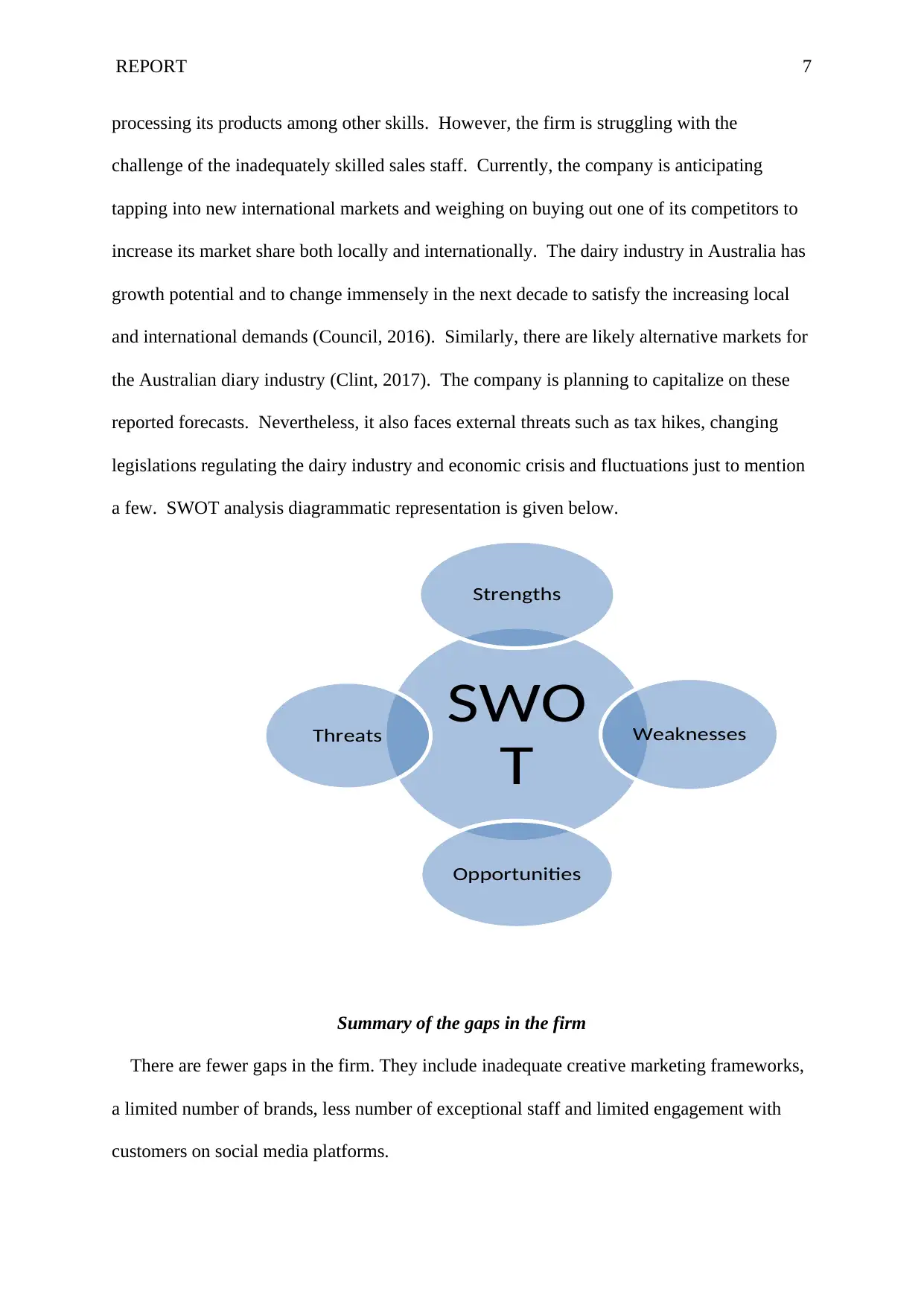
REPORT 7
processing its products among other skills. However, the firm is struggling with the
challenge of the inadequately skilled sales staff. Currently, the company is anticipating
tapping into new international markets and weighing on buying out one of its competitors to
increase its market share both locally and internationally. The dairy industry in Australia has
growth potential and to change immensely in the next decade to satisfy the increasing local
and international demands (Council, 2016). Similarly, there are likely alternative markets for
the Australian diary industry (Clint, 2017). The company is planning to capitalize on these
reported forecasts. Nevertheless, it also faces external threats such as tax hikes, changing
legislations regulating the dairy industry and economic crisis and fluctuations just to mention
a few. SWOT analysis diagrammatic representation is given below.
Summary of the gaps in the firm
There are fewer gaps in the firm. They include inadequate creative marketing frameworks,
a limited number of brands, less number of exceptional staff and limited engagement with
customers on social media platforms.
SWO
T
Strengths
Weaknesses
Opportunities
Threats
processing its products among other skills. However, the firm is struggling with the
challenge of the inadequately skilled sales staff. Currently, the company is anticipating
tapping into new international markets and weighing on buying out one of its competitors to
increase its market share both locally and internationally. The dairy industry in Australia has
growth potential and to change immensely in the next decade to satisfy the increasing local
and international demands (Council, 2016). Similarly, there are likely alternative markets for
the Australian diary industry (Clint, 2017). The company is planning to capitalize on these
reported forecasts. Nevertheless, it also faces external threats such as tax hikes, changing
legislations regulating the dairy industry and economic crisis and fluctuations just to mention
a few. SWOT analysis diagrammatic representation is given below.
Summary of the gaps in the firm
There are fewer gaps in the firm. They include inadequate creative marketing frameworks,
a limited number of brands, less number of exceptional staff and limited engagement with
customers on social media platforms.
SWO
T
Strengths
Weaknesses
Opportunities
Threats
Paraphrase This Document
Need a fresh take? Get an instant paraphrase of this document with our AI Paraphraser
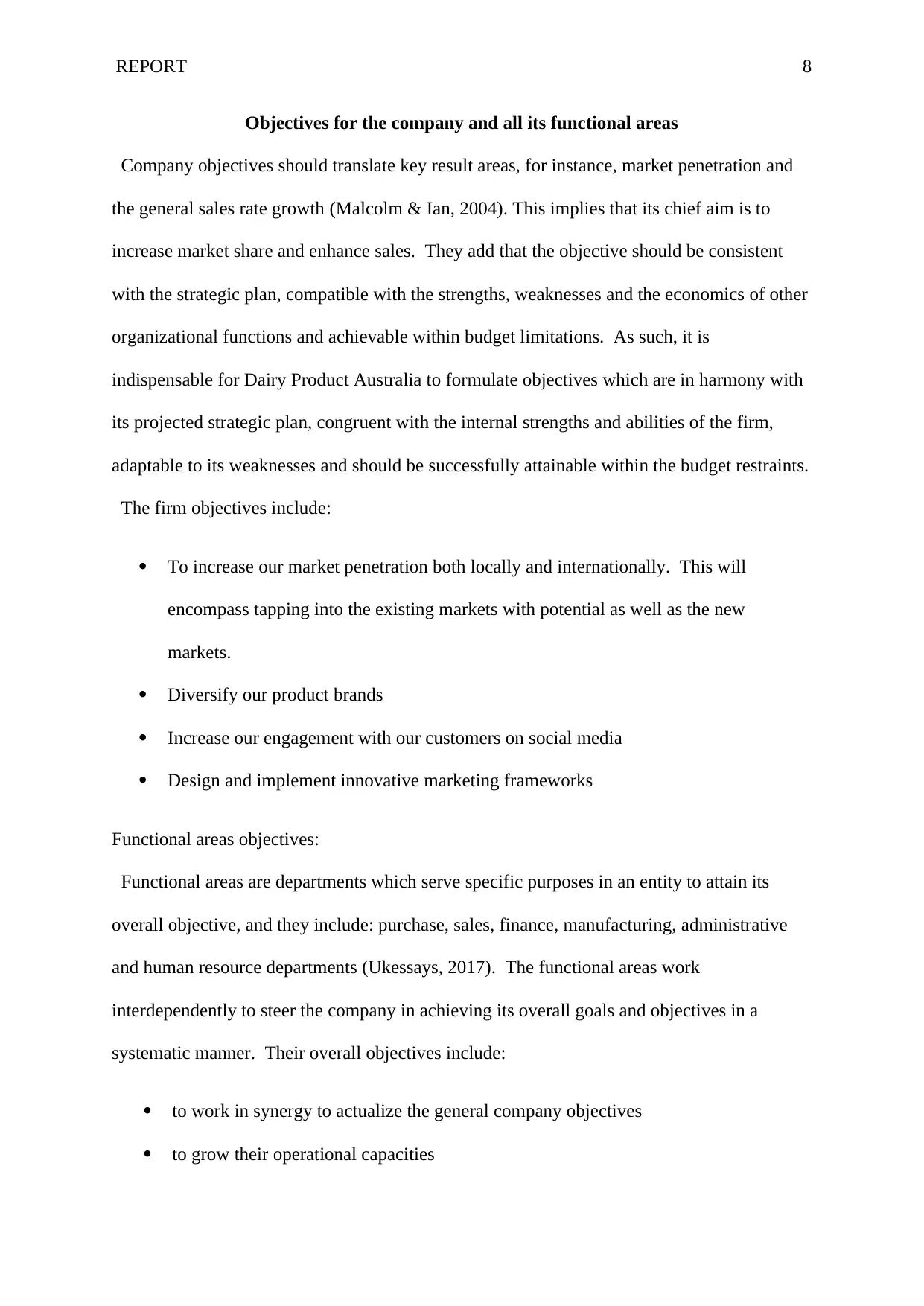
REPORT 8
Objectives for the company and all its functional areas
Company objectives should translate key result areas, for instance, market penetration and
the general sales rate growth (Malcolm & Ian, 2004). This implies that its chief aim is to
increase market share and enhance sales. They add that the objective should be consistent
with the strategic plan, compatible with the strengths, weaknesses and the economics of other
organizational functions and achievable within budget limitations. As such, it is
indispensable for Dairy Product Australia to formulate objectives which are in harmony with
its projected strategic plan, congruent with the internal strengths and abilities of the firm,
adaptable to its weaknesses and should be successfully attainable within the budget restraints.
The firm objectives include:
To increase our market penetration both locally and internationally. This will
encompass tapping into the existing markets with potential as well as the new
markets.
Diversify our product brands
Increase our engagement with our customers on social media
Design and implement innovative marketing frameworks
Functional areas objectives:
Functional areas are departments which serve specific purposes in an entity to attain its
overall objective, and they include: purchase, sales, finance, manufacturing, administrative
and human resource departments (Ukessays, 2017). The functional areas work
interdependently to steer the company in achieving its overall goals and objectives in a
systematic manner. Their overall objectives include:
to work in synergy to actualize the general company objectives
to grow their operational capacities
Objectives for the company and all its functional areas
Company objectives should translate key result areas, for instance, market penetration and
the general sales rate growth (Malcolm & Ian, 2004). This implies that its chief aim is to
increase market share and enhance sales. They add that the objective should be consistent
with the strategic plan, compatible with the strengths, weaknesses and the economics of other
organizational functions and achievable within budget limitations. As such, it is
indispensable for Dairy Product Australia to formulate objectives which are in harmony with
its projected strategic plan, congruent with the internal strengths and abilities of the firm,
adaptable to its weaknesses and should be successfully attainable within the budget restraints.
The firm objectives include:
To increase our market penetration both locally and internationally. This will
encompass tapping into the existing markets with potential as well as the new
markets.
Diversify our product brands
Increase our engagement with our customers on social media
Design and implement innovative marketing frameworks
Functional areas objectives:
Functional areas are departments which serve specific purposes in an entity to attain its
overall objective, and they include: purchase, sales, finance, manufacturing, administrative
and human resource departments (Ukessays, 2017). The functional areas work
interdependently to steer the company in achieving its overall goals and objectives in a
systematic manner. Their overall objectives include:
to work in synergy to actualize the general company objectives
to grow their operational capacities
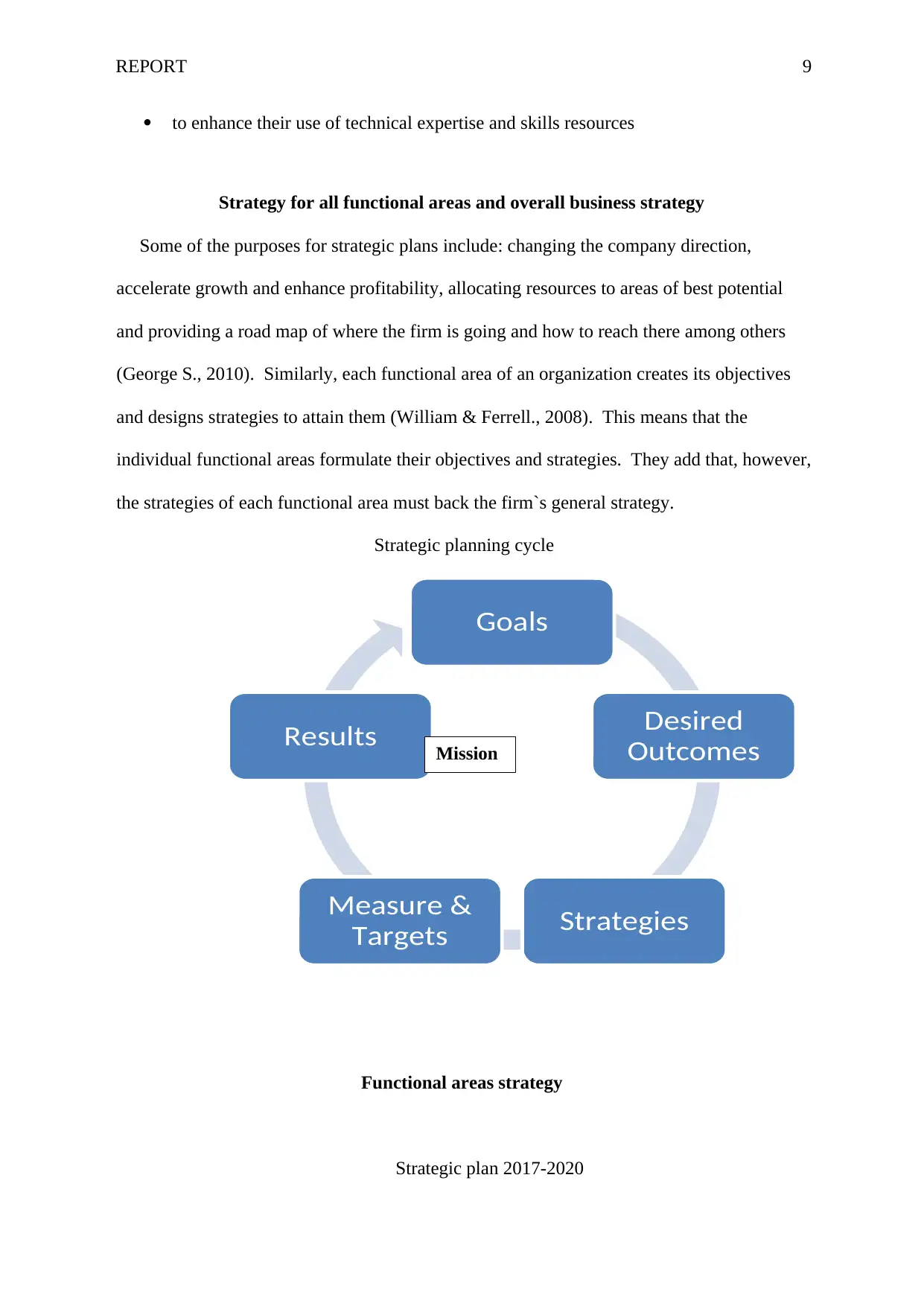
REPORT 9
to enhance their use of technical expertise and skills resources
Strategy for all functional areas and overall business strategy
Some of the purposes for strategic plans include: changing the company direction,
accelerate growth and enhance profitability, allocating resources to areas of best potential
and providing a road map of where the firm is going and how to reach there among others
(George S., 2010). Similarly, each functional area of an organization creates its objectives
and designs strategies to attain them (William & Ferrell., 2008). This means that the
individual functional areas formulate their objectives and strategies. They add that, however,
the strategies of each functional area must back the firm`s general strategy.
Strategic planning cycle
Functional areas strategy
Strategic plan 2017-2020
Goals
Desired
Outcomes
Strategies
Measure &
Targets
Results Mission
to enhance their use of technical expertise and skills resources
Strategy for all functional areas and overall business strategy
Some of the purposes for strategic plans include: changing the company direction,
accelerate growth and enhance profitability, allocating resources to areas of best potential
and providing a road map of where the firm is going and how to reach there among others
(George S., 2010). Similarly, each functional area of an organization creates its objectives
and designs strategies to attain them (William & Ferrell., 2008). This means that the
individual functional areas formulate their objectives and strategies. They add that, however,
the strategies of each functional area must back the firm`s general strategy.
Strategic planning cycle
Functional areas strategy
Strategic plan 2017-2020
Goals
Desired
Outcomes
Strategies
Measure &
Targets
Results Mission
⊘ This is a preview!⊘
Do you want full access?
Subscribe today to unlock all pages.

Trusted by 1+ million students worldwide
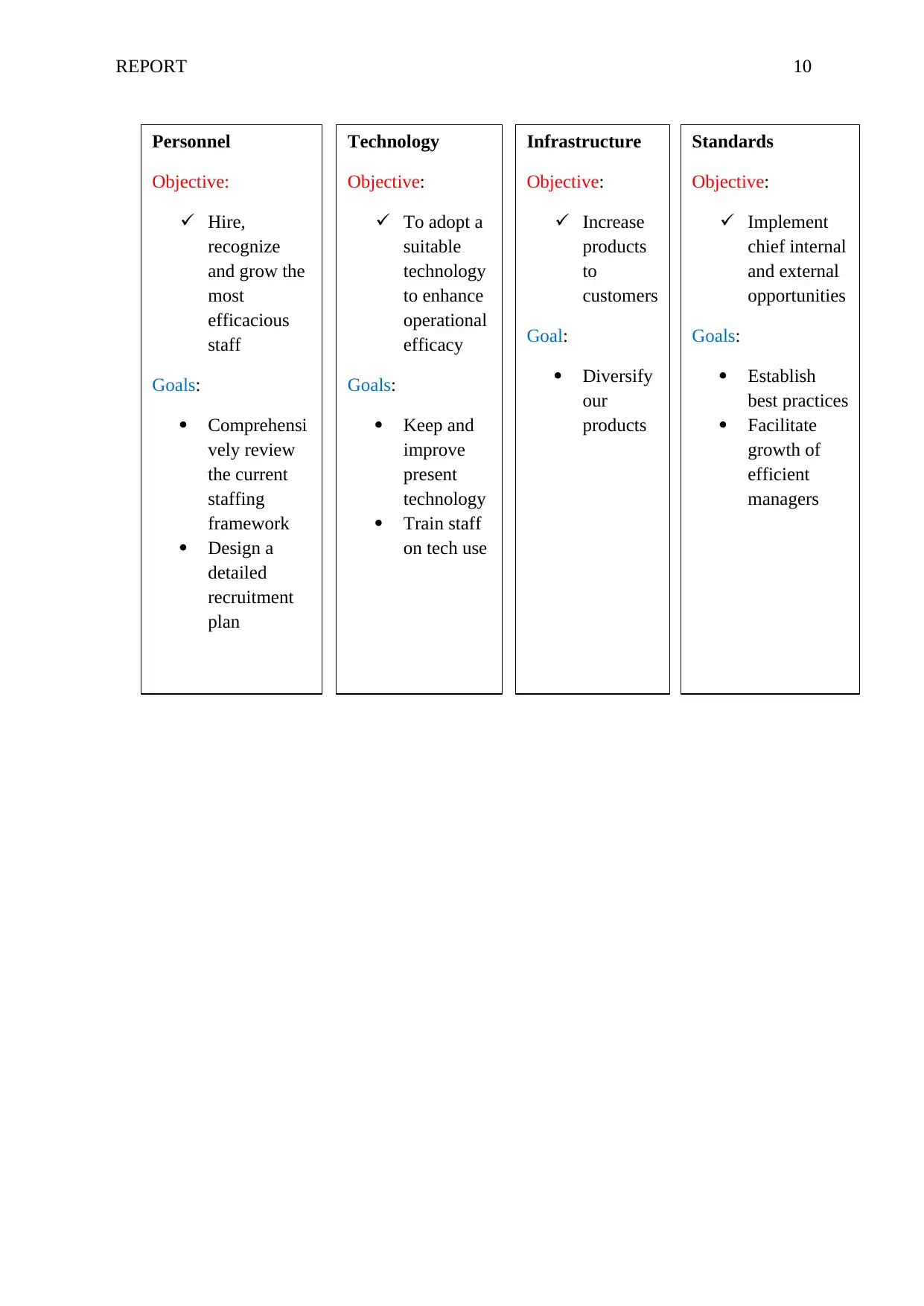
REPORT 10
Personnel
Objective:
Hire,
recognize
and grow the
most
efficacious
staff
Goals:
Comprehensi
vely review
the current
staffing
framework
Design a
detailed
recruitment
plan
Technology
Objective:
To adopt a
suitable
technology
to enhance
operational
efficacy
Goals:
Keep and
improve
present
technology
Train staff
on tech use
Infrastructure
Objective:
Increase
products
to
customers
Goal:
Diversify
our
products
Standards
Objective:
Implement
chief internal
and external
opportunities
Goals:
Establish
best practices
Facilitate
growth of
efficient
managers
Personnel
Objective:
Hire,
recognize
and grow the
most
efficacious
staff
Goals:
Comprehensi
vely review
the current
staffing
framework
Design a
detailed
recruitment
plan
Technology
Objective:
To adopt a
suitable
technology
to enhance
operational
efficacy
Goals:
Keep and
improve
present
technology
Train staff
on tech use
Infrastructure
Objective:
Increase
products
to
customers
Goal:
Diversify
our
products
Standards
Objective:
Implement
chief internal
and external
opportunities
Goals:
Establish
best practices
Facilitate
growth of
efficient
managers
Paraphrase This Document
Need a fresh take? Get an instant paraphrase of this document with our AI Paraphraser
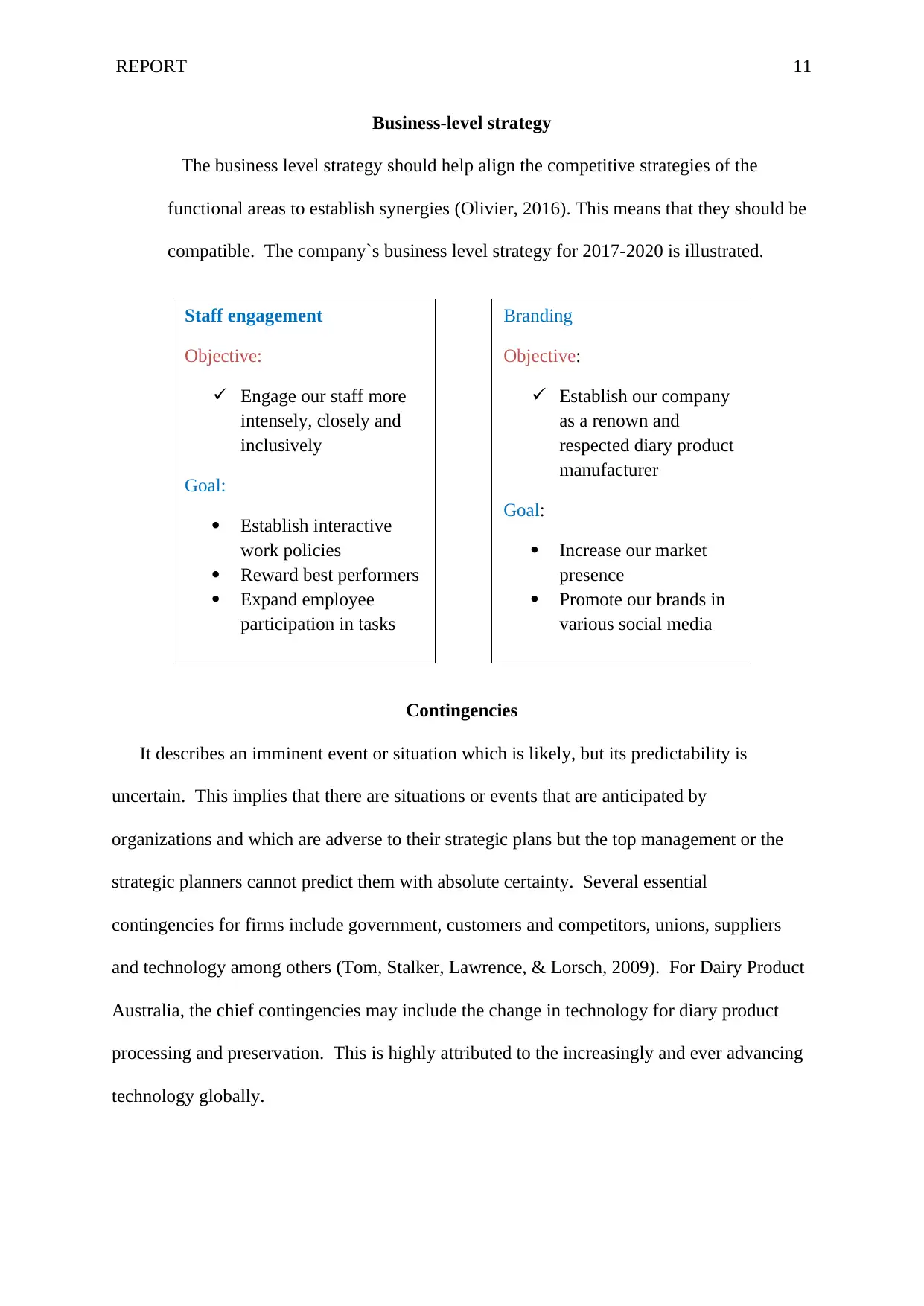
REPORT 11
Business-level strategy
The business level strategy should help align the competitive strategies of the
functional areas to establish synergies (Olivier, 2016). This means that they should be
compatible. The company`s business level strategy for 2017-2020 is illustrated.
Contingencies
It describes an imminent event or situation which is likely, but its predictability is
uncertain. This implies that there are situations or events that are anticipated by
organizations and which are adverse to their strategic plans but the top management or the
strategic planners cannot predict them with absolute certainty. Several essential
contingencies for firms include government, customers and competitors, unions, suppliers
and technology among others (Tom, Stalker, Lawrence, & Lorsch, 2009). For Dairy Product
Australia, the chief contingencies may include the change in technology for diary product
processing and preservation. This is highly attributed to the increasingly and ever advancing
technology globally.
Staff engagement
Objective:
Engage our staff more
intensely, closely and
inclusively
Goal:
Establish interactive
work policies
Reward best performers
Expand employee
participation in tasks
Branding
Objective:
Establish our company
as a renown and
respected diary product
manufacturer
Goal:
Increase our market
presence
Promote our brands in
various social media
Business-level strategy
The business level strategy should help align the competitive strategies of the
functional areas to establish synergies (Olivier, 2016). This means that they should be
compatible. The company`s business level strategy for 2017-2020 is illustrated.
Contingencies
It describes an imminent event or situation which is likely, but its predictability is
uncertain. This implies that there are situations or events that are anticipated by
organizations and which are adverse to their strategic plans but the top management or the
strategic planners cannot predict them with absolute certainty. Several essential
contingencies for firms include government, customers and competitors, unions, suppliers
and technology among others (Tom, Stalker, Lawrence, & Lorsch, 2009). For Dairy Product
Australia, the chief contingencies may include the change in technology for diary product
processing and preservation. This is highly attributed to the increasingly and ever advancing
technology globally.
Staff engagement
Objective:
Engage our staff more
intensely, closely and
inclusively
Goal:
Establish interactive
work policies
Reward best performers
Expand employee
participation in tasks
Branding
Objective:
Establish our company
as a renown and
respected diary product
manufacturer
Goal:
Increase our market
presence
Promote our brands in
various social media
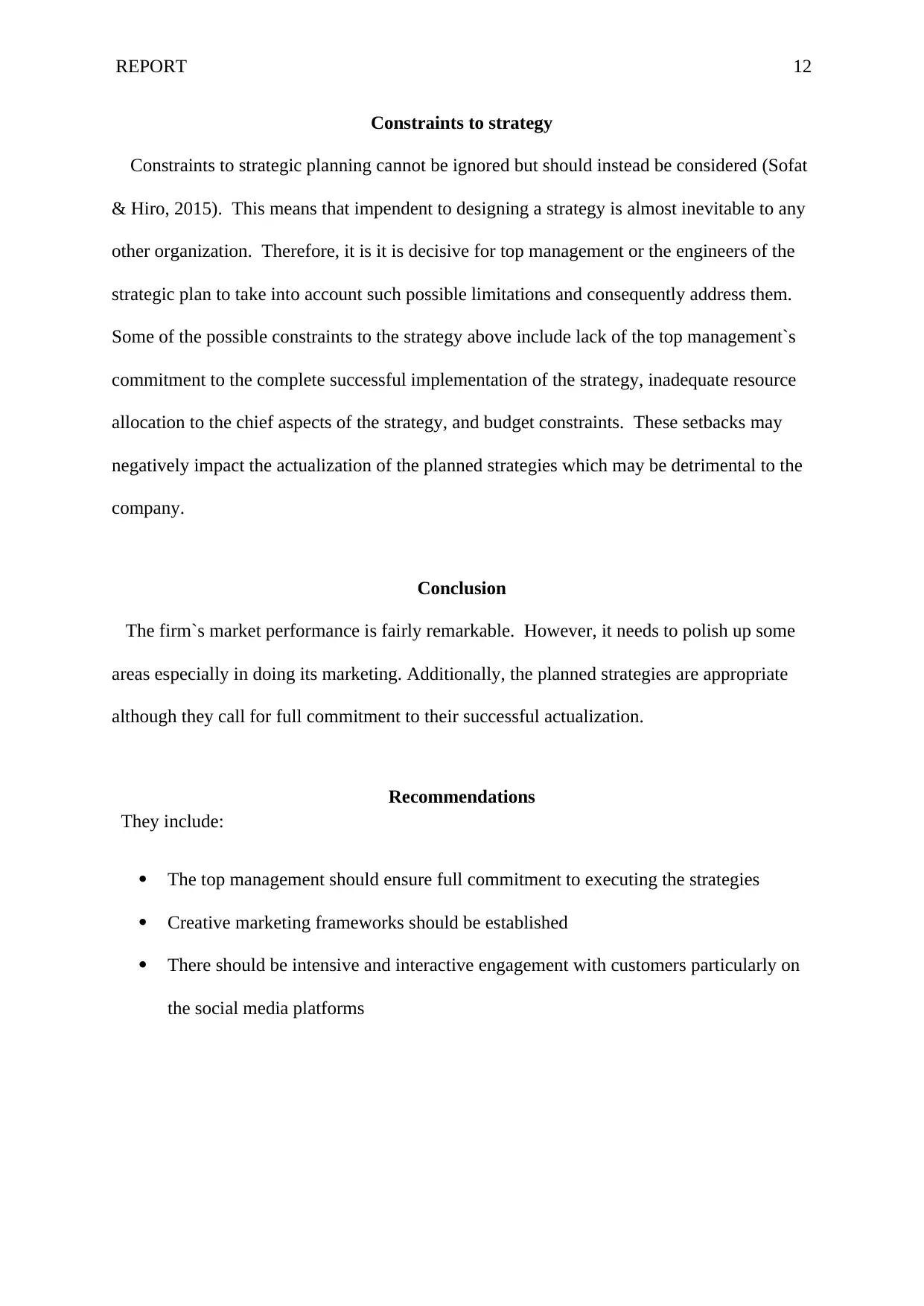
REPORT 12
Constraints to strategy
Constraints to strategic planning cannot be ignored but should instead be considered (Sofat
& Hiro, 2015). This means that impendent to designing a strategy is almost inevitable to any
other organization. Therefore, it is it is decisive for top management or the engineers of the
strategic plan to take into account such possible limitations and consequently address them.
Some of the possible constraints to the strategy above include lack of the top management`s
commitment to the complete successful implementation of the strategy, inadequate resource
allocation to the chief aspects of the strategy, and budget constraints. These setbacks may
negatively impact the actualization of the planned strategies which may be detrimental to the
company.
Conclusion
The firm`s market performance is fairly remarkable. However, it needs to polish up some
areas especially in doing its marketing. Additionally, the planned strategies are appropriate
although they call for full commitment to their successful actualization.
Recommendations
They include:
The top management should ensure full commitment to executing the strategies
Creative marketing frameworks should be established
There should be intensive and interactive engagement with customers particularly on
the social media platforms
Constraints to strategy
Constraints to strategic planning cannot be ignored but should instead be considered (Sofat
& Hiro, 2015). This means that impendent to designing a strategy is almost inevitable to any
other organization. Therefore, it is it is decisive for top management or the engineers of the
strategic plan to take into account such possible limitations and consequently address them.
Some of the possible constraints to the strategy above include lack of the top management`s
commitment to the complete successful implementation of the strategy, inadequate resource
allocation to the chief aspects of the strategy, and budget constraints. These setbacks may
negatively impact the actualization of the planned strategies which may be detrimental to the
company.
Conclusion
The firm`s market performance is fairly remarkable. However, it needs to polish up some
areas especially in doing its marketing. Additionally, the planned strategies are appropriate
although they call for full commitment to their successful actualization.
Recommendations
They include:
The top management should ensure full commitment to executing the strategies
Creative marketing frameworks should be established
There should be intensive and interactive engagement with customers particularly on
the social media platforms
⊘ This is a preview!⊘
Do you want full access?
Subscribe today to unlock all pages.

Trusted by 1+ million students worldwide
1 out of 14
Related Documents
Your All-in-One AI-Powered Toolkit for Academic Success.
+13062052269
info@desklib.com
Available 24*7 on WhatsApp / Email
![[object Object]](/_next/static/media/star-bottom.7253800d.svg)
Unlock your academic potential
Copyright © 2020–2025 A2Z Services. All Rights Reserved. Developed and managed by ZUCOL.





